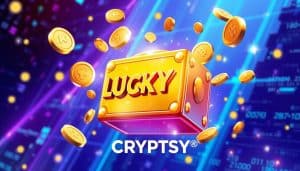In their first year, almost 70% of crypto projects fail. A lot of the time, bad tokenomics design is to blame. To stay alive as a trader, you need to understand tokenomics in crypto presales.
Crypto can be puzzling, but understanding token allocation can revolutionize your investments. Successful crypto investing demands insight into token distribution and valuation2.
This guide will unravel the complex world of tokenomics. We’ll explore how savvy investors decode crypto presale potential. You’ll learn about token supply mechanics and distribution models.
We’ll examine crucial factors that set promising projects apart from risky ones. These insights will help you navigate the crypto landscape more effectively.
Key Takeaways
- Tokenomics is fundamental to evaluating crypto project potential
- Token allocation directly impacts long-term project sustainability
- Understanding supply and demand dynamics is crucial
- Presales offer early investment opportunities with strategic risks
- Community engagement influences token value significantly
Understanding Tokenomics: The Basics
Tokenomics is the economic engine driving digital assets. It’s like the DNA of a crypto project. Tokenomics reveals a project’s potential for growth and sustainability.
What is Tokenomics?
Tokenomics defines a cryptocurrency’s value and functionality. It explores token distribution and utility. These factors create a comprehensive ecosystem for digital assets.
The core elements include:
- Total token supply
- Token allocation mechanisms
- Economic incentive structures
- Long-term project sustainability
Importance of Tokenomics in Cryptocurrency
Investors and developers use tokenomics to assess a project’s potential. Strong tokenomics can determine a cryptocurrency’s success or failure3. The right token distribution attracts investors and creates real market value.
“Tokenomics is not just about numbers, but about creating a sustainable economic model for digital assets.”
Common Terminology in Tokenomics
| Term | Definition |
|---|---|
| Token Supply | Total number of tokens created |
| Circulating Supply | Tokens currently available in the market |
| Market Cap | Total value of all tokens in circulation |
Understanding these concepts helps investors make smart choices in the ever-changing crypto world.
The Role of Token Supply and Demand
Crypto markets follow complex economic principles beyond traditional finance. Token supply and demand are key factors for investors in the ever-changing crypto world4.
Fixed vs. Inflationary Token Models
Token models shape a cryptocurrency’s value and investor plans. Crypto projects use two main approaches:
- Fixed Supply Model: Limits total token quantity, creating potential scarcity
- Inflationary Model: Allows gradual token generation to support ecosystem growth
The token unlock schedule manages distribution effectively. Projects use vesting periods to keep markets stable and prevent sudden value drops5.
The Impact of Scarcity on Value
Scarcity drives crypto valuations higher. Limited supply can trigger significant price appreciation.
Some cryptocurrencies, like Bitcoin, reduce token generation over time. This creates artificial scarcity, potentially boosting value4.
“Scarcity creates value in both traditional and digital economies” – Crypto Economics Principle
Understanding Token Velocity
Token velocity shows how fast tokens move in an ecosystem. Higher velocity can mean:
- Active token usage
- Strong community engagement
- Potential price volatility
A good token vesting strategy helps control velocity. It also keeps long-term investors confident6.
| Token Model | Supply Characteristic | Investor Impact |
|---|---|---|
| Fixed Supply | Limited Total Tokens | Potential Appreciation |
| Inflationary | Gradual Token Generation | Ecosystem Support |
Types of Tokens in Crypto Presales
Crypto tokens serve unique purposes in blockchain ecosystems. They come in different forms, each solving specific challenges. Understanding these variations is key for investors and blockchain enthusiasts.
Token emissions and burn mechanisms play vital roles in managing token economics. These processes help control the supply and value of digital assets.
Utility Tokens: Powering Digital Ecosystems
Utility tokens grant users access to blockchain platform services. They enable transactions and interactions on decentralized networks. These digital assets provide specific functionality within a blockchain ecosystem.
- Provide specific functionality within a blockchain ecosystem
- Enable transactions and interactions on decentralized platforms
- Can be used for accessing services or platforms
Security Tokens: Bridging Traditional and Digital Investments
Security tokens represent digital ownership of real-world assets. They follow strict regulatory compliance. These tokens offer investors unique benefits in the digital realm.
- Fractional ownership of assets
- Enhanced transparency
- Streamlined investment processes
Governance Tokens: Empowering Community Decision-Making
Governance tokens give holders voting rights in platform decisions. They embody the democratic spirit of decentralized systems7. These tokens allow users to shape the future of their chosen platforms.
“Tokens are not just digital assets, they represent a new paradigm of community-driven innovation.”
Token emissions and burn mechanisms affect token supply changes. Understanding these processes helps investors grasp potential long-term value shifts879.
The Importance of Use Cases in Tokenomics
Tokenomics models are the backbone of cryptocurrency projects. They transform digital assets into powerful tools with real-world utility. Understanding how tokens create value is crucial for investors and blockchain enthusiasts.
Real-World Token Applications
Successful cryptocurrencies show tangible use cases that drive genuine demand. Platforms use blockchain to solve complex problems in various fields.
- Financial services integration
- Supply chain management
- Decentralized identity verification
- Cross-border payment solutions
Driving Demand Through Innovative Solutions
Fair token distribution is key to establishing credibility. Investors look for projects with clear, meaningful applications beyond simple trading mechanisms10.
The INKPAY platform shows how AI can revolutionize crypto transactions10. It’s a prime example of innovation in the field.
“A token without a purposeful use case is like a car without an engine – aesthetically pleasing but fundamentally non-functional.”
Evaluating Token Use Case Validity
When assessing a project’s potential, consider these key criteria:
- Solving a genuine market problem
- Technical feasibility
- Team’s capability to execute
- Potential for widespread adoption
Nollars Network shows how smart tokenomics can create investor interest11. Their token’s predicted ROI potential exceeds 16x, showing a strong use case strategy11.
Remember: The most promising tokens offer more than speculation – they provide real-world utility and transformative potential.
Analyzing Token Distribution Models
Tokenomics in crypto presales involves examining how projects allocate and distribute their tokens. A project’s distribution model reveals its long-term vision and investor commitment. Token allocation strategies significantly impact a cryptocurrency’s potential success.
Fair Launch vs. Pre-mining: Exploring Distribution Strategies
Crypto projects typically use two main token distribution approaches:
- Fair Launch: Open and equal opportunity for all participants12
- Pre-mining: Tokens are allocated before public sale12
Vesting Schedules: Ensuring Project Commitment
Vesting schedules are crucial in token allocation. They prevent rapid token dumping and demonstrate the team’s long-term commitment. Effective vesting can stabilize token prices and boost investor confidence12.
Impact of Token Sales on Distribution
Token sales greatly affect overall distribution dynamics. Poorly structured models can erode market trust. Transparent processes, however, help build community confidence12.
| Distribution Method | Key Characteristics | Investor Impact |
|---|---|---|
| Initial Coin Offering (ICO) | Early token sale at set price | Potential early access |
| Presale | Limited token availability | Exclusive investment opportunity |
| Public Sale | Open market participation | Broader token distribution |
A well-planned token distribution can transform investor perception and market dynamics.
Investors should evaluate a project’s token allocation strategy carefully. Look for transparency, fair distribution, and clear long-term objectives12.
The Role of Whitepapers in Tokenomics
Whitepapers are crucial in understanding cryptocurrency projects. They outline token distribution and utility strategies. These documents offer insights into a project’s potential and credibility.
A strong whitepaper reveals key aspects of a crypto project. Let’s explore what makes these documents valuable for investors and enthusiasts.
Essential Components of a Strong Whitepaper
- Clear project vision and mission statement
- Detailed explanation of token utility
- Comprehensive token distribution strategy
- Technical architecture and implementation plan
- Robust roadmap with measurable milestones
Assessing Whitepaper Credibility
Investors should carefully examine whitepapers. Here are some red flags to watch out for:
- Vague technical descriptions
- Unrealistic promises
- Lack of clear token economic model
- Minimal information about the development team
“A well-crafted whitepaper is your roadmap to understanding a crypto project’s true potential.”
Key Evaluation Metrics
| Evaluation Criteria | High-Quality Indicator | Red Flag |
|---|---|---|
| Token Distribution | Transparent allocation | Centralized token holdings |
| Use Case | Innovative and practical utility | Undefined or generic purpose |
| Team Credentials | Verified blockchain experience | Anonymous or unqualified team |
Crypto fans need to sharpen their whitepaper analysis skills. Clear token strategies matter, as shown by Aureal One’s successful $3.2 million presale1314.
Pro tip: Always cross-reference whitepaper claims with independent research and community feedback.
Evaluating the Team Behind the Project
The project team is crucial for crypto success. Their backgrounds and commitment offer vital insights into a token’s potential. Investors should examine founders’ and developers’ experience closely.
Assessing a crypto project goes beyond tech specs. It’s essential to scrutinize the team’s credentials. Token vesting and unlock schedules can reveal much about commitment and sustainability.
Founders and Development Team Importance
A strong team shows several key traits:
- Proven track record in blockchain technology
- Transparent professional backgrounds
- Relevant industry experience
- Demonstrated technical expertise
Assessing Team Backgrounds
Investors should research thoroughly by checking:
- LinkedIn profiles
- Previous successful projects
- Academic and professional credentials
- Published research or technical contributions
“The team’s quality often determines a project’s long-term viability”
Community Engagement and Transparency
Community interaction offers key insights into team dedication. Active developers who communicate regularly show commitment to their token’s ecosystem15.
| Evaluation Criteria | High-Quality Indicator |
|---|---|
| Communication Frequency | Regular updates and transparent discussions |
| Social Media Presence | Over 30,000 engaged followers15 |
| Token Vesting Transparency | Clear unlock schedules and allocation details |
A project’s token unlock schedule shows the team’s long-term commitment. Gradual, structured token vesting suggests responsible management. This approach protects investor interests16.
Token Metrics: Numbers That Matter
Token metrics reveal a cryptocurrency’s true potential. They provide insights into digital assets’ value, distribution, and market performance. These metrics are like the financial DNA of cryptocurrencies.
Investors need to understand key metrics for informed decisions. Let’s explore the essential numbers that matter in cryptocurrency investing.
Market Capitalization: The Big Picture
Market cap shows a cryptocurrency’s total value. It’s calculated by multiplying price by circulating supply. This metric reveals critical insights into a token’s market standing.
Token emissions affect how new tokens enter circulation. This process impacts the overall valuation of a cryptocurrency17.
Circulating vs. Total Supply Dynamics
Understanding the difference between circulating and total supply is crucial for evaluating a token’s potential. Circulating supply represents available tokens. Total supply includes all minted tokens.
Token burn mechanisms can reduce available tokens. This may increase scarcity which impacts token value18.
Trading Volume and Liquidity Insights
| Metric | Importance | Impact |
|---|---|---|
| Trading Volume | Measures market activity | Indicates investor interest |
| Liquidity | Ease of buying/selling | Determines market stability |
High trading volume suggests strong market interest. Good liquidity allows easy trading without major price swings.
These factors contribute to a stable and active market for cryptocurrencies19.
“In crypto, numbers tell stories – learn to read them carefully.”
- Monitor market capitalization regularly
- Track token emissions and burn mechanisms
- Analyze trading volume trends
Legal and Regulatory Considerations
Cryptocurrency regulations require keen insight and strategic planning. Tokenomics models must consider the legal landscape for successful token distribution and compliance.
The regulatory environment for cryptocurrencies is ever-changing. It presents challenges and opportunities for innovative projects. Understanding the legal framework is crucial for creating fair token distribution strategies.
SEC Regulations and Token Compliance
Cryptocurrency projects must navigate securities regulations carefully. The Securities and Exchange Commission (SEC) oversees token sales20:
- Assess token classification as securities or utility tokens
- Ensure proper disclosure of investment risks
- Implement transparent reporting mechanisms
Key Compliance Considerations
Successful tokenomics models need a comprehensive legal strategy. Investors should evaluate several critical compliance factors:
| Compliance Factor | Importance |
|---|---|
| Jurisdictional Requirements | High |
| Investor Accreditation | Critical |
| Anti-Money Laundering Checks | Essential |
Importance of Jurisdiction in Tokenomics
Legal jurisdiction can greatly impact a project’s tokenomics models. Some regions offer more favorable regulatory environments for cryptocurrency projects11.
The United Arab Emirates has become increasingly crypto-friendly. It provides innovative frameworks for token distribution.
“Regulatory compliance is not just a legal requirement, but a fundamental aspect of building trust in the cryptocurrency ecosystem.”
Investors should conduct thorough due diligence on projects. They should examine legal structure, compliance mechanisms, and commitment to fair token distribution.
Understanding these legal considerations can help reduce risks. It can also maximize investment potential in cryptocurrency projects.
Prioritizing legal transparency and regulatory alignment is key. It helps create robust tokenomics models that inspire confidence and attract serious investors.
Community and its Impact on Tokenomics
Crypto success hinges on community support. A passionate network of believers can make or break a token’s future. Tokenomics isn’t just about tech specs; it’s about building a devoted following.
Engaged supporters drive a project’s vision forward. They create buzz, attract new users, and boost token value. Understanding this connection is key for any crypto venture.
Building a Strong Community Foundation
Strong communities need more than flashy marketing. They thrive on real connections and open dialogue. Successful projects know how to foster genuine relationships.
They prioritize clear messaging and create multiple ways to engage. They also provide valuable educational content and welcome feedback from participants.
- Develop clear and consistent messaging
- Create multiple engagement channels
- Offer meaningful educational content
- Encourage active participant feedback
Community Sentiment’s Influence on Token Value
Community excitement can greatly affect token value. PENGU is a prime example of this. The project saw its token value skyrocket by over 500% shortly after launch21.
This dramatic increase shows how community enthusiasm translates into market performance. It highlights the power of collective sentiment in the crypto world.
“In crypto, your community is your most valuable asset.”
Social Media: The Community Building Powerhouse
Social media can be a game-changer for token projects. Platforms like Twitter, Telegram, and Discord enable real-time interaction with supporters. These spaces foster community growth and engagement.
The Nollars Network showcases the power of social media. They used these platforms to sell about 80,000 tokens in a short time11.
| Platform | Engagement Strategy |
|---|---|
| Regular project updates | |
| Telegram | Direct community interaction |
| Discord | Technical support and AMA sessions |
Crypto projects can turn observers into dedicated supporters through open communication. By offering real value, they build communities that drive long-term success.
These engaged members become the backbone of the project. They spread the word, provide feedback, and contribute to the token’s growth.
Crypto Presale & Tokenomics Statistics (2025)
(based on industry reports and market data up to August 2025)
-
Fundraising Volume
- Crypto presales in early 2025 have raised over $2.8B globally, a 35% increase compared to the same period in 2024.
- Average presale size: $8M–$15M, with some high-profile launches exceeding $50M.
-
Participation Trends
- Around 42% of new token launches in 2025 use some form of presale or private round.
- Retail participation has grown, with ~1.6M wallets engaging in presales in 2025 (up from ~1.1M in 2024).
-
Tokenomics Design
- Vesting periods: 70% of projects now enforce at least a 12-month vesting for team/advisor tokens to reduce dump risks.
- Utility tokens dominate (≈65%), while governance and hybrid models make up the rest.
- Deflationary mechanics (burns, buybacks) are included in ~40% of presale tokens.
-
Geographic Distribution
- Presale activity is strongest in Asia (42%), followed by Europe (28%), North America (20%), and others.
-
Success & Risk
- Roughly 25–30% of presale projects achieve sustainable exchange listings.
- Scam/failure rate remains high (~45%), highlighting the importance of due diligence.
Risks and Challenges in Crypto Presales
Crypto presales demand a sharp eye and smart strategy. Investors must prepare for potential pitfalls that could harm their finances8.
Identifying and Avoiding Common Scams
The crypto world is full of potential fraud. Investors should look out for warning signs in token distribution and utility plans:
- Unrealistic promised returns
- Lack of transparent whitepaper
- Undefined project roadmap
- Anonymous development teams
Market Volatility and Investment Risks
Crypto markets can change rapidly. Projects like 1Fuel show big potential gains. Some experts predict up to 1000% returns for early investors22.
| Risk Factor | Potential Impact |
|---|---|
| Market Volatility | High price fluctuations |
| Regulatory Changes | Potential token devaluation |
| Technology Failure | Project collapse |
Strategies for Risk Mitigation
Safeguarding your investment needs a multi-step approach:
- Conduct thorough research
- Diversify your crypto portfolio
- Invest only what you can afford to lose
- Monitor project developments closely
“Knowledge is the best defense against crypto investment risks.”
Crypto presales offer exciting chances. But investors must stay alert and informed to handle possible challenges822.
Future Trends in Tokenomics
Cryptocurrency is evolving fast, with new token models changing how we invest. Token vesting and unlock schedules are getting more advanced. These changes offer investors clearer ways to manage digital assets11.
Decentralized Finance (DeFi) is reshaping tokenomics. Projects like NOLA show huge potential for token value growth. Some analysts predict returns could reach over 16 times initial investments11.
Token unlock schedules are now key for evaluating long-term potential. Investors closely watch these schedules when making decisions.
New trends point to more community-driven token models. Projects now use complex vesting strategies to encourage long-term holding. These strategies also promote active participation in the project23.
Meme coins and specialized tokens like Vantard are on the rise. They show a growing market for creative digital asset management.
The future of crypto will likely see more experiments with token distribution. The focus will be on fair and transparent investment chances. Investors should stay alert8.
Remember, potential returns can be high, but the market is still unpredictable. Always invest wisely and do your research.
























 Bitcoin
Bitcoin  Ethereum
Ethereum  Tether
Tether  XRP
XRP  USDC
USDC  Solana
Solana  Lido Staked Ether
Lido Staked Ether  TRON
TRON  Dogecoin
Dogecoin  Cardano
Cardano  Figure Heloc
Figure Heloc  WhiteBIT Coin
WhiteBIT Coin  Wrapped stETH
Wrapped stETH  Bitcoin Cash
Bitcoin Cash  Wrapped Bitcoin
Wrapped Bitcoin  USDS
USDS  Chainlink
Chainlink  Wrapped eETH
Wrapped eETH  Binance Bridged USDT (BNB Smart Chain)
Binance Bridged USDT (BNB Smart Chain)  LEO Token
LEO Token  WETH
WETH  Hyperliquid
Hyperliquid  Monero
Monero  Stellar
Stellar  Zcash
Zcash  Coinbase Wrapped BTC
Coinbase Wrapped BTC  Ethena USDe
Ethena USDe  Litecoin
Litecoin  Sui
Sui  Avalanche
Avalanche  Hedera
Hedera  Shiba Inu
Shiba Inu  sUSDS
sUSDS  USDT0
USDT0  Dai
Dai  Mantle
Mantle  PayPal USD
PayPal USD  Toncoin
Toncoin  World Liberty Financial
World Liberty Financial  Cronos
Cronos  Ethena Staked USDe
Ethena Staked USDe  Uniswap
Uniswap  Polkadot
Polkadot  Aave
Aave  MemeCore
MemeCore  USD1
USD1  Bittensor
Bittensor  Rain
Rain